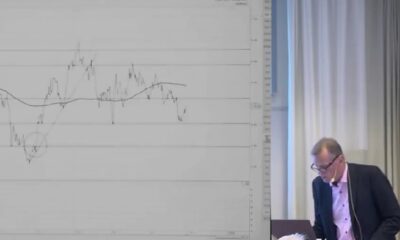Analys från DailyFX
Making Sense of the Fed’s Non-Taper
Talking Points:
– Global risk markets – stocks, emerging market bonds, high yield FX – are all rallying.
– FOMC meeting primes liquidity pump through at least December at $85B/month.
– The US Dollar’s rise is inevitable – so long as the economics warrant recently higher yields.
To receive this report in your inbox every morning, sign up for Christopher’s distribution list.
INTRADAY PERFORMANCE UPDATE: 09:45 GMT
Dow Jones FXCM Dollar Index (Ticker: USDOLLAR): +0.12% (-1.53%prior 5-days)
ASIA/EUROPE FOREX NEWS WRAP
The Dow Jones FXCM Dollar Index has hit fresh 3Q’13 lows and is now at its lowest levels since mid-June – support ahead of the June 19 FOMC meeting. That was the meeting that sparked summer speculation that the Fed would reduce its QE3 program “later in the year,” which more or less translated into September.
But that was then and this is now, and the Fed surprised market participants across the globe by choosing to maintain QE3 at $85B/month. (Global markets are loving the news: the Indonesian stock market rallied as far as +7.36% overnight before settling for a more modest +4.65%, if to highly the exuberance displayed.) Investors seem to be caught in a state of confusion over the Fed’s decision to maintain its current policy path. I find said logic to be flawed.
In recent months, there were clear signs that the labor market was stumbling, and recent softer inflation data had stoked concerns about broader economic weakness. In June, the Fed said it would be open to tapering QE3 dependent on incoming data. Incoming data – specifically for labor and inflation – hasn’t been screaming “taper QE3.”
In fact, the Fed did exactly what it said it would do – base decisions on incoming data, not some preset timeline to wind down stimulus as markets had expected. Some points to make on the data the Fed used to not taper QE3:

– Consumer Price Index 12-month average, May versus August (the most readily available data at the June and September meetings, respectively): +1.7% versus +1.7%.
– Conclusion: CPI remains below the Fed’s +2% yearly target, and it lacks upside momentum.
– Change in Nonfarm Payrolls 3-month average, May versus August: +172K versus +148K; 12-month average: +181K versus +184K.
– Conclusion: the labor market is steady, but not strong.
The data the Fed has been watching – especially since June – has not shown signs of improvement. Incoming data didn’t develop appropriately. Bond markets, then, have deceived investors the past few months, not the Fed. So when will the taper begin?
There is talk about tapering in October, but that makes little sense given that one of Chairman Bernanke’s main concerns – an intransigent Congress that has become a veritable drag on the economy – will come to flourish as Democrats and Republicans square off over the next debt limit debate.
A December taper seems more likely – but that of course will be contingent on inflation moving higher and jobs growth accelerating. Above all, that the key takeaway is that it will only take one or two strong, important data (Advance Retail Sales, NFPs) to revive taper speculation; and then the US Dollar can recover more broadly.
NZDUSD 5-minute Chart: September 18 to 19, 2013 Intraday

Taking a look at European credit, the Euro has been boosted versus the US Dollar despite a drop in yields across the continent; US yields have dropped more over the past 24-hours, and widening yield differentials have proven to be EURUSD positive on Thursday.
The Italian 2-year note yield has decreased to 1.815% (-5.6-bps) while the Spanish 2-year note yield has decreased to 1.578% (-6.8-bps). Similarly, the Italian 10-year note yield has decreased to 4.314% (-8.2-bps) while the Spanish 10-year note yield has decreased to 4.347% (-4.4-bps); lower yields imply higher prices.
Read more: British Pound, Japanese Yen Rally Before FOMC – What to Watch For Today
ECONOMIC CALENDAR – UPCOMING NORTH AMERICAN SESSION

See the DailyFX Economic Calendar for a full list, timetable, and consensus forecasts for upcoming economic indicators. Want the forecasts to appear right on your charts? Download the DailyFX News App.
— Written by Christopher Vecchio, Currency Analyst
To contact Christopher Vecchio, e-mail cvecchio@dailyfx.com
Follow him on Twitter at @CVecchioFX
To be added to Christopher’s e-mail distribution list, please fill out this form
Analys från DailyFX
EURUSD Weekly Technical Analysis: New Month, More Weakness
What’s inside:
- EURUSD broke the ‘neckline’ of a bearish ‘head-and-shoulders’ pattern, April trend-line
- Resistance in vicinity of 11825/80 likely to keep a lid on further strength
- Targeting the low to mid-11600s with more selling
Confidence is essential to successful trading, see this new guide – ’Building Confidence in Trading’.
Coming into last week we pointed out the likelihood of finally seeing a resolution of the range EURUSD had been stuck in for the past few weeks, and one of the outcomes we made note of as a possibility was for the triggering of a ’head-and-shoulders’ pattern. Indeed, we saw a break of the ’neckline’ along with a drop below the April trend-line. This led to decent selling before a minor bounce took shape during the latter part of last week.
Looking ahead to next week the euro is set up for further losses as the path of least resistance has turned lower. Looking to a capper on any further strength there is resistance in the 11825-11880 area (old support becomes new resistance). As long as the euro stays below this area a downward bias will remain firmly intact.
Looking lower towards support eyes will be on the August low at 11662 and the 2016 high of 11616, of which the latter just happens to align almost precisely with the measured move target of the ‘head-and-shoulders’ pattern (determined by subtracting the height of the pattern from the neckline).
Bottom line: Shorts look set to have the upperhand as a fresh month gets underway as long as the euro remains capped by resistance. On weakness, we’ll be watching how the euro responds to a drop into support levels.
For a longer-term outlook on EURUSD, check out the just released Q4 Forecast.
EURUSD: Daily
—Written by Paul Robinson, Market Analyst
You can receive Paul’s analysis directly via email bysigning up here.
You can follow Paul on Twitter at@PaulRobinonFX.
Analys från DailyFX
Euro Bias Mixed Heading into October, Q4’17

Why and how do we use IG Client Sentiment in trading? See our guide and real-time data.
EURUSD: Retail trader data shows 37.3% of traders are net-long with the ratio of traders short to long at 1.68 to 1. In fact, traders have remained net-short since Apr 18 when EURUSD traded near 1.07831; price has moved 9.6% higher since then. The number of traders net-long is 15.4% lower than yesterday and 16.4% higher from last week, while the number of traders net-short is 0.4% higher than yesterday and 10.5% lower from last week.
We typically take a contrarian view to crowd sentiment, and the fact traders are net-short suggests EURUSD prices may continue to rise. Positioning is more net-short than yesterday but less net-short from last week. The combination of current sentiment and recent changes gives us a further mixed EURUSD trading bias.
— Written by Christopher Vecchio, CFA, Senior Currency Strategist
To contact Christopher Vecchio, e-mail cvecchio@dailyfx.com
Follow him on Twitter at @CVecchioFX
To be added to Christopher’s e-mail distribution list, please fill out this form
Analys från DailyFX
British Pound Reversal Potential Persists Heading into New Quarter

Why and how do we use IG Client Sentiment in trading? See our guide and real-time data.
GBPUSD: Retail trader data shows 38.2% of traders are net-long with the ratio of traders short to long at 1.62 to 1. In fact, traders have remained net-short since Sep 05 when GBPUSD traded near 1.29615; price has moved 3.4% higher since then. The number of traders net-long is 0.1% higher than yesterday and 13.4% higher from last week, while the number of traders net-short is 10.6% lower than yesterday and 18.3% lower from last week.
We typically take a contrarian view to crowd sentiment, and the fact traders are net-short suggests GBPUSD prices may continue to rise. Yet traders are less net-short than yesterday and compared with last week. Recent changes in sentiment warn that the current GBPUSD price trend may soon reverse lower despite the fact traders remain net-short.
— Written by Christopher Vecchio, CFA, Senior Currency Strategist
To contact Christopher Vecchio, e-mail cvecchio@dailyfx.com
Follow him on Twitter at @CVecchioFX
To be added to Christopher’s e-mail distribution list, please fill out this form
-
Analys från DailyFX10 år ago
EUR/USD Flirts with Monthly Close Under 30 Year Trendline
-
Marknadsnyheter5 år ago
BrainCool AB (publ): erhåller bidrag (grant) om 0,9 MSEK från Vinnova för bolagets projekt inom behandling av covid-19 patienter med hög feber
-

 Marknadsnyheter3 år ago
Marknadsnyheter3 år agoUpptäck de bästa verktygen för att analysera Bitcoin!
-
Analys från DailyFX12 år ago
Japanese Yen Breakout or Fakeout? ZAR/JPY May Provide the Answer
-

 Marknadsnyheter2 år ago
Marknadsnyheter2 år agoDärför föredrar svenska spelare att spela via mobiltelefonen
-
Analys från DailyFX12 år ago
Price & Time: Key Levels to Watch in the Aftermath of NFP
-
Analys från DailyFX8 år ago
Gold Prices Falter at Resistance: Is the Bullish Run Finished?
-

 Nyheter7 år ago
Nyheter7 år agoTeknisk analys med Martin Hallström och Nils Brobacke











